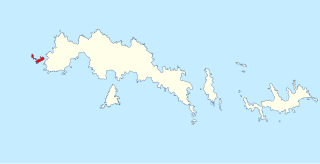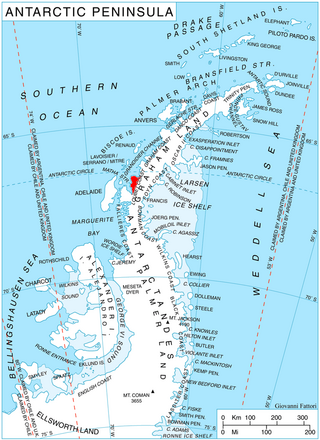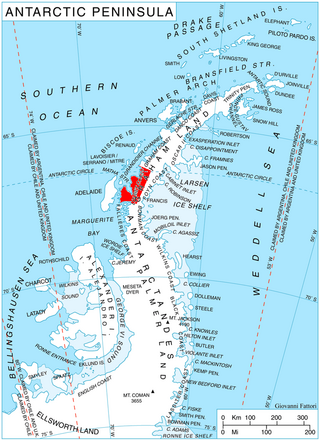Related Research Articles

The Larsen Islands are a small group of islands north-west of Moreton Point, the western extremity of Coronation Island, in the South Orkney Islands of Antarctica. They were discovered by Captains George Powell and Nathaniel Palmer on the occasion of their joint cruise in December 1821. The islands were named on Petter Sørlle's chart, based upon his survey of the South Orkney Islands in 1912–1913, in honour of Carl Anton Larsen.
Irving Island is a small island at the northeastern end of the Barcroft Islands, in the Biscoe Islands, Antarctica. It is situated 1.18 km east of St. Brigid Island and 1.9 km north of St. Isidore Island. The island was mapped from air photos taken by the Falkland Islands and Dependencies Aerial Survey Expedition (1956–57), and was named by the UK Antarctic Place-Names Committee for Laurence Irving, an American physiologist who has specialized in the effects of a polar environment.
Breakbones Plateau is a small lava plateau just north of Chimaera Flats on Candlemas Island, South Sandwich Islands. The feature is an interesting biological area containing numerous small fumaroles with attendant vegetation. The name applied by the United Kingdom Antarctic Place-Names Committee in 1971 refers both to the difficulty of travel and to the presence of a large breeding colony of giant petrels, sometimes known as "breakbones".
Buddha Rock is a rock, 35 metres (115 ft) high, lying 0.3 nautical miles (0.6 km) west of Vindication Island in the South Sandwich Islands. It was charted and named in 1930 by Discovery Investigations personnel on the RSS Discovery II.
Cauldron Pool is a hot, brackish steaming pond located east of Tow Bay and below the west slopes of volcanically active Lucifer Hill, in northwest Candlemas Island, South Sandwich Islands. The descriptive name, suggestive of a cauldron, was applied by the UK Antarctic Place-Names Committee in 1971.
Chimaera Flats is a broad stretch of flat sand with a smooth surface only a few metres above sea level, between Medusa Pool and Gorgon Pool on Candlemas Island, South Sandwich Islands. The name applied by the UK Antarctic Place-Names Committee in 1971 refers to the chimaera, a mythical fire-eating monster.
Cook Rock is an arched rock, 45 metres (150 ft) high, lying close east of Trousers Rock and 0.3 nautical miles (0.6 km) northeast of Vindication Island in the South Sandwich Islands. It was charted in 1930 by Discovery Investigations personnel on the Discovery II and named for Captain James Cook.

Weir Glacier is a glacier 8 nautical miles (15 km) long, flowing north into the south part of Barilari Bay between Prestoy Point and Byaga Point, on the west coast of Graham Land. First sighted and roughly charted in 1909 by the French Antarctic Expedition under Charcot. It was surveyed in 1935-36 by the British Graham Land Expedition (BGLE) under Rymill and later named for William D. Weir, 1st Viscount Weir of Eastwood, and his son, the Hon. James K. Weir, who contributed toward the cost of the BGLE, 1934–37.
Crosscut Point is a series of jagged rocks forming the north end of Vindication Island in the South Sandwich Islands. It was charted in 1930 by Discovery Investigations personnel on the Discovery II, and so named because numerous crosscutting dikes have withstood weathering and produced this irregular formation.
Kraken Cove is the largest cove at Candlemas Island, South Sandwich Islands, indenting the north coast of the island, just west of Demon Point and north of Gorgon Pool. The name applied by the UK Antarctic Place-Names Committee in 1971 is that of a legendary Norwegian sea monster, the Kraken.
The Dorsey Mountains are a mountain range just east of Somigliana Glacier in the northern part of the Arrowsmith Peninsula in Graham Land. They were mapped by the Falkland Islands Dependencies Survey (FIDS) from surveys and air photos in 1956 to 1959 and named by the UK Antarctic Place-Names Committee (UK-APC) for Noah Ernest Dorsey, an American physicist.
Mount Perseus is the lower and more northerly of twin ice domes in the east part of Candlemas Island, South Sandwich Islands. Named by United Kingdom Antarctic Place-Names Committee (UK-APC) in 1971 in association with nearby Mount Andromeda. In Greek mythology, Perseus married Andromeda after rescuing her from a sea monster.
Gorgon Pool is a lake, or perhaps lagoon, between the Chimaera Flats and Kraken Cove in Candlemas Island, South Sandwich Islands. It was named by the UK Antarctic Place-Names Committee in association with nearby Medusa Pool. The Gorgon is a mythical creature of Homer's Iliad, linked in other mythology with Medusa.
Gorgons Head is a peak southeast of Mount Hughes in the Cook Mountains of Antarctica. The peak is sandstone with dolerite intrusions and is a sharp summit ridge. It was named after the Gorgons, three winged creatures of Greek mythology only one of which (Medusa) could be killed by having its head cut off.
Lucifer Hill is a reddish, cindery, sulphur-streaked hill forming the summit of the northern section of Candlemas Island in the South Sandwich Islands. It was one of the most active volcanic vents in this island chain at the time of HMS Protector's survey in 1964. The name applied by the UK Antarctic Place-Names Committee after Lucifer refers to the diabolical and infernal mythical association of active volcanoes. Clinker Gulch extends from Lucifer Hill to the northern shore of Candlemas.
Medusa Peak is a peak, 1,700 metres (5,600 ft) high, located southeast of Perseus Peak on Tentacle Ridge in the Cook Mountains of Antarctica. It was named is association with other peaks in the area after Medusa, one of the three gorgons of Greek mythology.
Mount Machatschek is a prominent, mainly snow-covered mountain in northern Adelaide Island, Antarctica, about 14 nautical miles (26 km) southwest of Mount Velain. It was mapped from air photos taken by the Ronne Antarctic Research Expedition (1947–48) and the Falkland Islands and Dependencies Aerial Survey Expedition (1956–57), and was named by the UK Antarctic Place-Names Committee after Austrian geomorphologist Fritz Machatschek (1876–1957), who was the joint author with Erich von Drygalski of Gletscherkunde, 1942.
Sarcophagus Point is a point at the southeast side of Sea Serpent Cove on the west coast of Candlemas Island, South Sandwich Islands. The point, with a spine of lava cliffs, almost cuts off Medusa Pool from the sea. It was referred to as "The Sarcophagus" on a sketch-survey of Sea Serpent Cove made by a boat party from RRS Discovery II in 1930.

Sölch Glacier is a glacier on the Pernik Peninsula of the Loubet Coast in Graham Land, flowing west to Salmon Cove just north of Kanchov Peak on the east side of Lallemand Fjord. It was mapped from air photos taken by the Falkland Islands and Dependencies Aerial Survey Expedition, 1956–57, and named by United Kingdom Antarctic Place-Names Committee for Johann Sölch (1883–1951), an Austrian glacial geologist and glaciologist.

Hopkins Glacier is a glacier situated south of Erskine Glacier and flowing westwards into the head of Tlachene Cove in Darbel Bay on the west coast of Graham Land, Antarctica. It was photographed by Hunting Aerosurveys Ltd in 1955–57, and mapped from these photos by the Falkland Islands Dependencies Survey. It was named by the UK Antarctic Place-Names Committee in 1958 for Sir Frederick Hopkins, founder of the School of Biochemistry at Cambridge University, who made pioneer investigations on synthetic diets and vitamins which contributed greatly to the development of present ideas on concentrated rations.
References
- ↑ "Medusa Pool". Geographic Names Information System . United States Geological Survey, United States Department of the Interior . Retrieved 12 September 2013.
![]() This article incorporates public domain material from "Medusa Pool". Geographic Names Information System . United States Geological Survey.
This article incorporates public domain material from "Medusa Pool". Geographic Names Information System . United States Geological Survey.